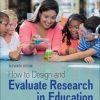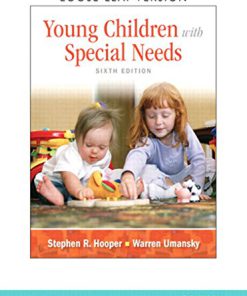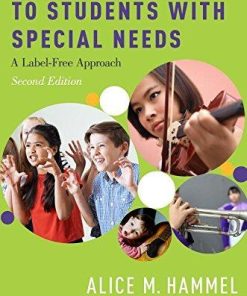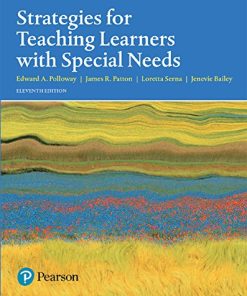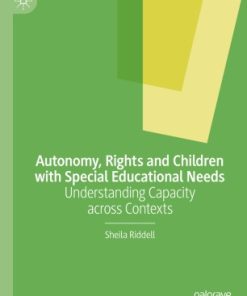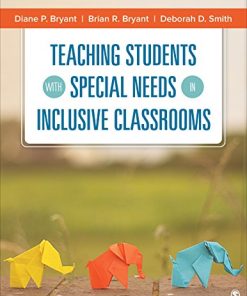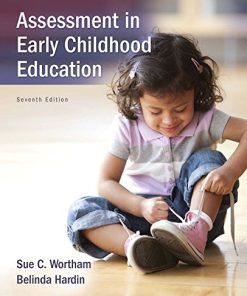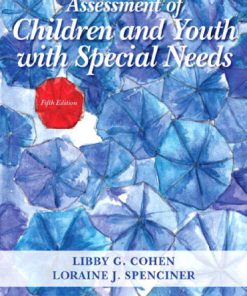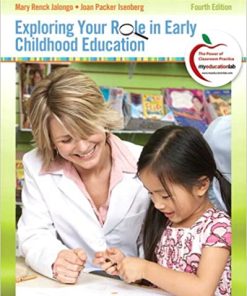Strategies for Including Children with Special Needs in Early Childhood Settings 2nd Edition by Ruth Cook 8214353531 9798214353531
$50.00 Original price was: $50.00.$25.00Current price is: $25.00.
Strategies for Including Children with Special Needs in Early Childhood Settings 2nd Edition by Ruth E. Cook – Ebook PDF Instant Download/DeliveryISBN: 8214353531, 9798214353531
Full download Strategies for Including Children with Special Needs in Early Childhood Settings 2nd Edition after payment.
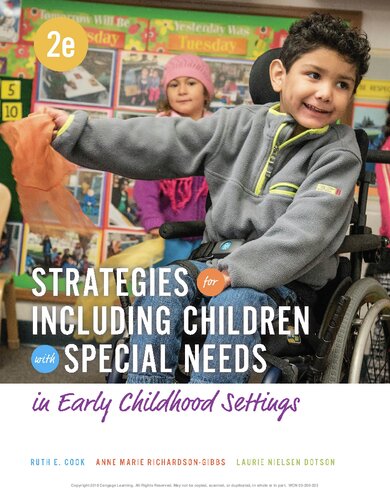
Product details:
ISBN-10 : 8214353531
ISBN-13 : 9798214353531
Author : Ruth E. Cook
This practical, hands-on-guide encompasses workable ideas on how to include and support young children with disabilities in all preschool classrooms. Teaching strategies and adaptations are offered by program activity rather than by disability, so you can more easily coordinate adaptations to each part of your lesson plan. The main focus is on embedding instruction within daily routines. The text incorporates simple and direct language that builds on the foundation of information learned about children without disabilities. Chapters are short and include many examples for supporting children with a variety of common disabilities such as cerebral palsy, Down syndrome, autism, visual impairment, hearing loss, and behavioral challenges. Whether you’re a student working in general or special education, you will find the strategies, helpful hints, and scenarios to be useful resources when accommodating children with special needs in your current or future classroom.
Strategies for Including Children with Special Needs in Early Childhood Settings 2nd Table of contents:
Chapter 1. The Origin and Dimensions of Quality Inclusion
1-1. Historical Overview of Special Education Law and Inclusion
1-1a. Americans with Disabilities Act: Provision of Equal Opportunity for All
1-1b. Head Start
1-1c. A Major Shift in Service Delivery
1-2. Defining Features of High-Quality Early Childhood Inclusion
1-3. Dimensions of Inclusion Support
1-4. Delivery of Supports and Services in Inclusive Preschool Settings
1-4a. Direct versus Indirect (Consultative) Supports
1-4b. Collaboration: The Key to Successful Inclusion
1-4c. Pull-Out versus Push-In
1-4d. Examples of Inclusion Support “Models”
1-5. Benefits of Inclusion
Summary
Read–Reflect–Discuss
Key Terms
Helpful Resources
Chapter 2. Instructional Strategies Supporting the Inclusion of Young Children with Special Needs
2-1. Adaptation Strategies: The Bridge to Facilitating Inclusion
2-1a. Levels of Support
2-1b. Tools that Facilitate Adaptations
2-2. Universal Teaching Strategies: Specific Challenges
2-2a. Getting Their Attention
2-2b. Conducting a High-Preference Inventory
2-2c. Unique Ways of Expressing Interest and Attention
2-3. Working in the Learning Zone: Understanding the Zone of Proximal Development
2-3a. Scaffolding
2-4. Doing it Again and Again: The Importance of Repetition and Routine
2-4a. Creating Predictable Routines
2-4b. Planning Transitions
2-5. One Step at a Time: Making Skills Easier to Learn Through Task Analysis
2-5a. Analyzing the Sequence
2-5b. Training Each Step
2-6. Talking to Children Makes a Difference
2-6a. Follow the Child’s Lead
2-6b. Use Progressive Matching
2-6c. Use Labels and Specific Descriptors
2-6d. Repeat Key Words and Phrases
2-6e. Use Appropriate Pacing
2-6f. Give Children Ample Time to Respond
2-6g. Create the Need to Communicate
2-7. Using an Ounce of Prevention: Managing Challenging Behavior
2-7a. Strategies to Head Off Behavior Challenges
2-8. Instructional Strategies for Children with Mild to Moderate Disabilities
Summary
Read–Reflect–Discuss
Key Terms
Helpful Resources
Chapter 3. Adaptations for Children with Specific Disabilities
3-1. Children with Down Syndrome: A Common Example of Intellectual Disabilities
3-1a. Physical and Health Characteristics
3-1b. Teaching Strategies
3-2. Children with Autism
3-2a. Characteristics of Autism
3-2b. Intervention/Treatment Approaches
3-2c. Behavior Challenges in Children with Autism
3-2d. Teaching Strategies for Children with Autism Spectrum Disorders
3-3. Children with Cerebral Palsy and Other Motor Impairments
3-3a. Characteristics of Children with Cerebral Palsy (CP)
3-3b. Teaching Considerations for Children with Motor Disabilities
3-4. Children with Visual Impairment
3-4a. Characteristics of Visual Impairment
3-4b. General Categories of Visual Impairment
3-4c. Strategies for Working with Children with Visual Impairments
3-5. Children with Hearing Impairment
3-5a. Understanding Different Types of Hearing Loss
3-5b. Issues Related to Preferred Communication Modes: Signing versus Speech
3-5c. Learning Styles and Characteristics of Children with Hearing Loss
3-5d. Teaching Strategies for Children with Hearing Loss
3-6. High-Incidence Disabilities
3-6a. Learning Disability
3-6b. Speech and Language Impairment
Summary
Read–Reflect–Discuss
Key Terms
Helpful Resources
Chapter 4. Arranging the Physical Environment to Support the Inclusion of Children with Special Needs
4-1. Creating a Safe Environment
4-1a. Psychological Safety
4-1b. Physical Safety
4-1c. Encouraging Independent Access
4-2. Floor Plan Considerations for Children with Special Needs
4-2a. Need for Quiet Area
4-2b. Avoidance of Large Open Areas
4-2c. Consideration of Some Children’s Preference for Enclosed Space
4-2d. Need for Acoustic Adaptations
4-2e. Visually Simple Presentation of Materials to Reduce Clutter
4-3. Planning Activity Areas for Children with Special Needs
4-3a. Library Corner
4-3b. Art and Water Play Area
4-3c. Tabletop Manipulatives Center
4-3d. Building Area
4-3e. Dramatic Play Area
4-3f. Technology Center
4-4. Arranging Materials within Activity Areas
4-4a. Visibility and Consistency
4-4b. Accessibility
4-4c. Labeling
4-4d. Traffic Management
4-4e. Noise Control
4-4f. Lighting
4-5. Designing Specific Activity Centers
4-5a. Reading/Preliteracy Areas
4-5b. Sensory Experiences, Art, and Water Play Centers
4-5c. Small Manipulative Activity Centers
4-5d. Outdoor Play Areas
Summary
Read–Reflect–Discuss
Key Terms
Helpful Resources
Chapter 5. Preventing and Managing Challenging Behaviors
5-1. What Is a Challenging Behavior Anyway?
5-2. Behavior Challenges in Children with Special Needs
5-2a. Neurological Disorders
5-2b. Autism
5-2c. Communication Disorders
5-2d. Seizure Disorders
5-3. Causes/Functions of Inappropriate Behavior
5-3a. Escape
5-3b. Attention Seeking
5-3c. Gaining Access
5-4. The Impact of Language Differences on Behavior
5-5. General Strategies for Preventing and Reducing the Occurrence of Challenging Behaviors
5-5a. Keep the Number of Rules/Expectations Small
5-5b. Select Rules/Expectations Carefully
5-5c. Be Clear and Consistent about Enforcement
5-5d. Avoid Overstimulating, Disorganized Environments
5-5e. Maintain a Predictable Daily Schedule with Regular Routines
5-5f. Carefully Plan Transitions
5-5g. Give Attention Before Inappropriate Behavior Occurs
5-5h. Use Touch to De-Escalate Behavior
5-6. Multitiered Systems of Support
5-7. Behavior Modification and the Use of Functional Behavior Assessment and Positive Behavior Support
5-7a. Identifying a Reinforcer
5-7b. Decreasing Undesirable Behaviors
5-7c. Use of Extinction
5-7d. Problems with the Use of Punishment/Negative Consequences
5-8. Designing Positive Behavior Support Plans
5-8a. Understanding Challenging Behaviors as Communication
5-9. Assigning a One-to-One Aide
5-9a. A Word of Caution on the Use of One-to-One Aides
Summary
Read–Reflect–Discuss
Key Terms
Helpful Resources
Chapter 6. Monitoring Individual Child Progress
6-1. The Individualized Family Service Plan (IFSP)
6-1a. Family Concerns
6-1b. Outcome Statements
6-2. The Individualized Education Program (IEP)
6-2a. Identifying Individuals Responsible for Achievement of Goals
6-2b. Goals and Objectives
6-2c. Daily Instructional Objectives
6-3. Monitoring Progress
6-3a. Implementation of the IEP and IFSP Goals and Objectives
6-3b. Rationale for Progress Monitoring
6-3c. Types of Data Recording
6-3d. Issues Related to Resources for Progress Monitoring
6-4. Planning Inclusion Support
Summary
Read–Reflect–Discuss
Key Terms
Helpful Resources
Chapter 7. Managing Arrival, Departure, and Other Transitions
7-1. Arrival
7-1a. Arrival: The Challenge of a New Experience
7-1b. Learning Opportunities during Arrival
7-1c. Useful Strategies during Arrival Time
7-2. Planning Effective Departures
7-2a. Establish a Consistent Departure Routine
7-2b. Support Development of Time Concepts
7-2c. When Children Arrive and Depart via Bus Transportation
7-3. Planning Other Transitions
7-3a. Challenges Posed by Transitions
7-3b. Learning Opportunities during Transitions
7-3c. Successful Transition Strategies
7-3d. Examples of Effective Transition Cues
Summary
Read–Reflect–Discuss
Key Terms
Helpful Resources
Chapter 8. Engaging Children with Special Needs in Free Play
8-1. Possible Challenges of Free Play for Children with Special Needs
8-2. Special Opportunities to Assist Learning in Free Play
8-2a. An Opportunity for Self-Initiated Exploration
8-2b. Teaching Children How to Play with Toys
8-2c. Opportunities for One-on-One Interaction
8-2d. Building Language Skills during Free Play
8-2e. Demonstrating Interaction and Teaching Strategies to Families
8-2f. Encouraging Children to Play with Peers
8-2g. Helping to Develop Crowd Tolerance
8-3. Selecting Toys and Materials for Free Play
8-3a. Toys that Appeal to Different Developmental Levels
8-3b. Considerations for Children who are Developmentally Young
8-3c. Common Toy and Activity Categories
Summary
Read–Reflect–Discuss
Key Terms
Helpful Resources
Chapter 9. Circle Time, including Music and Rhythm Activities
9-1. Learning Opportunities During Circle Time
9-1a. Opportunities for Creating a Sense of Community and a Sense of Self
9-1b. Opportunities to Encourage Speech and Language Skills
9-1c. Opportunities to Enhance Physical Awareness
9-1d. Opportunities to Support and Reinforce Emergent Literacy
9-1e. Opportunities to Support Cognitive Development
9-2. Types of Circle Time Activities and Adaptations for Children with Special Needs
9-2a. Attendance: Who Is Here Today?
9-2b. Classroom Schedules and Calendars
9-2c. Songs and Finger Plays
9-2d. Books and Stories
9-2e. Introduce New Activities or Concepts
9-2f. Transitions to Next Activity
9-2g. Final Considerations
9-3. Key Dimensions of Circle Time
9-3a. Length
9-3b. Physical Setting
9-3c. Teacher Roles
9-3d. Circle Time Expectations
9-3e. Balance of Circle Time Activities
9-3f. Consistency with Flexibility at Circle Time
9-4. Examples of Detailed Activity Plans
9-4a. Toddler Circle Time Activity: What’s in the Box?
9-4b. Preschool Circle Time Activity: Follow the Leader
Summary
Read–Reflect–Discuss
Key Terms
Helpful Resources
Chapter 10. Tabletop Activities
10-1. Value of Tabletop Activities
10-1a. Fine Motor Skills for School Readiness
10-1b. Task Sequencing
10-1c. Demonstrating Cause and Effect
10-1d. Learning Key Vocabulary and Concepts
10-2. Planning Tabletop Activities for Children with Special Needs
10-2a. Providing a Clear Transition
10-3. Supporting Learning Objectives Through Tabletop Activities
10-3a. Fine and Gross Motor Skills
10-3b. Developing Cognitive Skills
10-3c. Learning Key Vocabulary and Concepts
10-3d. Development of Representational Skills
10-3e. Enhancing Early Math Skills
10-4. Strategies for Children with Tactile Defensiveness
10-4a. Use Hand-Under-Hand Guidance
10-4b. Use the Premack Principle
10-4c. Incorporate the Child’s Security Object
10-4d. Provide Physical Boundaries
10-4e. Provide Role Models
Summary
Read–Reflect–Discuss
Key Terms
Helpful Resources
Chapter 11. Outside Play
11-1. Opportunities for Learning in the Outdoor Environment
11-1a. Change of Environment
11-1b. Opportunities for Using Large Muscles
11-1c. Developing Play Skills
11-1d. Developing Social Skills
11-1e. Opportunities for Sand and Water Play
11-2. Encouraging Peers to Play with Children with Special Needs
11-3. Planning the Outdoor Environment
11-3a. Start with a Survey
11-3b. Selecting Materials for Outside Areas
11-4. Sample Outside Lesson Plan: Discovery Walk
Summary
Read–Reflect–Discuss
Key Terms
Helful Resources
Chapter 12. Mealtimes
12-1. Learning Opportunities at Snack Times and Mealtimes
12-1a. Developing Self-Feeding Skills
12-1b. Teaching Other Self-Help Skills
12-1c. Developing Social Skills
12-1d. Encouraging Communication Skills
12-1e. Demonstrating Mealtime Techniques
12-2. Special Nutritional Considerations
12-2a. Children with Cerebral Palsy
12-2b. Children with Epilepsy (Seizure Disorders)
12-2c. Children with Low Muscle Tone
12-2d. Children with Autism
12-2e. Children with Prader-Willi Syndrome
12-2f. Children with Pica
12-2g. Children who Require Tube Feeding
12-3. A Word About Toileting
Summary
Read–Reflect–Discuss
Key Terms
Helpful Resources
Chapter 13. Supporting Language and Emergent Literacy in Children with Special Needs
13-1. The Relationship Between Language and Literacy
13-2. Supporting Literacy within Daily Routines
13-2a. Environmental Print
13-2b. Functional Print
13-2c. Play Activities
13-2d. Literacy Activities throughout the Daily Schedule
13-3. Assisting Children with Special Needs by Using Pictures and Print
13-3a. Pictures and Print as Alternative Means of Expressive Language
13-3b. Using Pictures to Assist Comprehension and Memory
13-3c. Use of Technology Apps to Support Communication and Literacy
Summary
Read–Reflect–Discuss
Key Terms
Helpful Resources
Chapter 14. Communicating and Collaborating with Families
14-1. Guidelines for Developing Parent-Professional Partnerships
14-1a. Development of Trust
14-1b. Recognizing Parents’ Knowledge and Expertise
14-1c. Families Are the Constant in Their Children’s Lives
14-1d. Making the Program Fit the Family’s Priorities
14-2. Recognizing the Stresses Families Face
14-2a. Dealing with Multiple Needs and Multiple Agencies and Professionals
14-2b. Increased Time Demands and the Need to Set Priorities
14-3. Understanding Families’ Emotional Reactions
14-3a. Strategies for Supporting Families’ Emotional Reactions
14-4. Communication: The Key to Building Partnerships
14-4a. Providing Information
14-4b. Developing Effective Communication Skills
Summary
Read–Reflect–Discuss
Key Terms
Helpful Resources
Chapter 15. Collaborating with Disability Specialists and Paraprofessionals
15-1. The Collaborative Intervention Team
15-1a. Early Childhood Special Educators (ECSEs)
15-1b. Inclusion Support Specialists
15-1c. Speech-Language Specialists
15-1d. Physical Therapists (PTs)
15-1e. Occupational Therapists (OTs)
15-1f. Visual Impairment (VI) Specialists
15-1g. Orientation and Mobility Specialists (O & M)
15-1h. Deaf and Hard of Hearing (DHH) Specialists
15-1i. Behavior Specialists
15-2. Obtaining and Using Inclusion Support
15-3. Working Effectively with Paraeducators
15-3a. Early Educators as Program Managers
15-3b. Early Educators as Coaches
15-3c. Early Educators as Communicators
15-4. Early Educators, Paraeducators, and Disability Specialists as a Collaborative Team
15-4a. Collaborative Problem Solving
People also search for Strategies for Including Children with Special Needs in Early Childhood Settings 2nd:
strategies for inclusion
strategies for inclusion of students with disabilities
strategies for children’s bad behaviour
strategies for children’s behaviour management
strategies for children boston
Tags: Strategies, Including Children, Special Needs, Early Childhood, Ruth Cook
You may also like…
Politics & Philosophy


